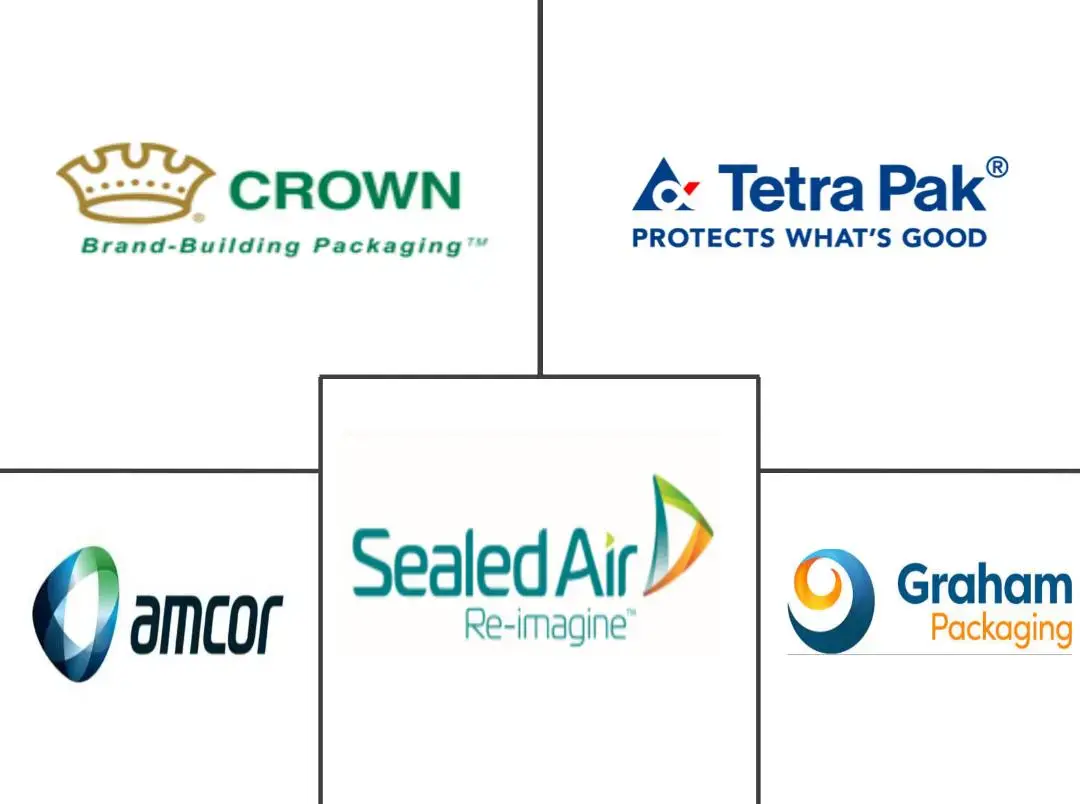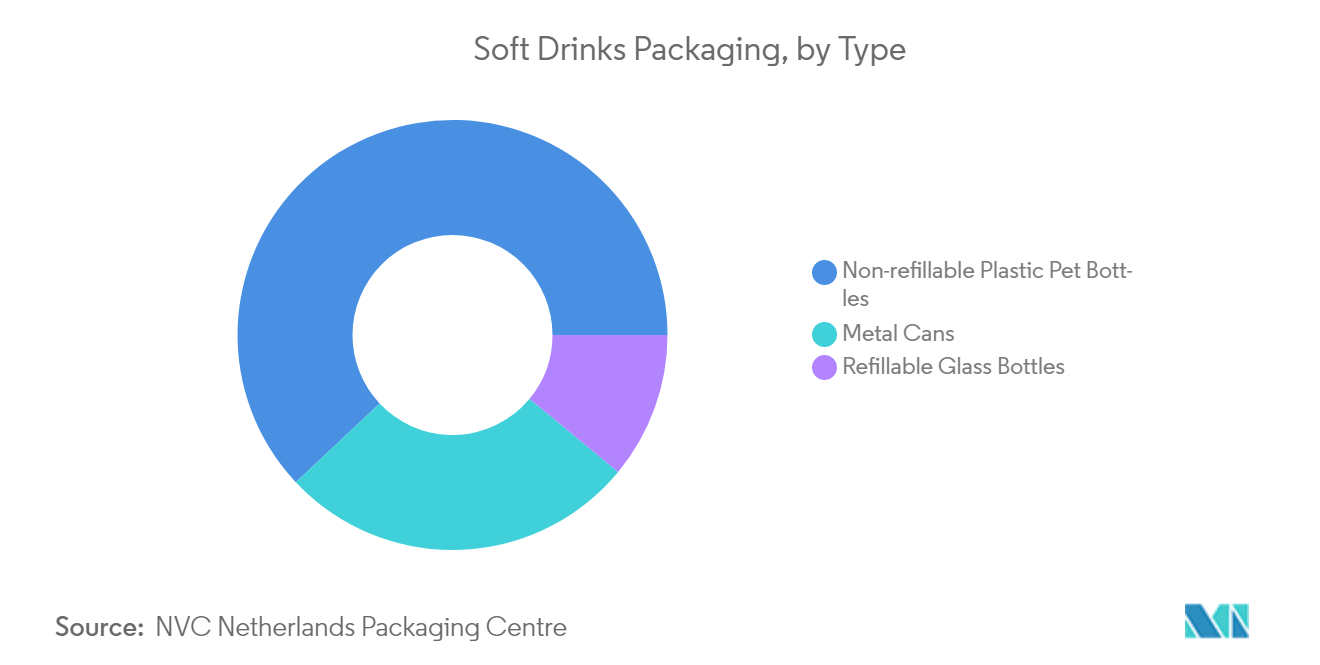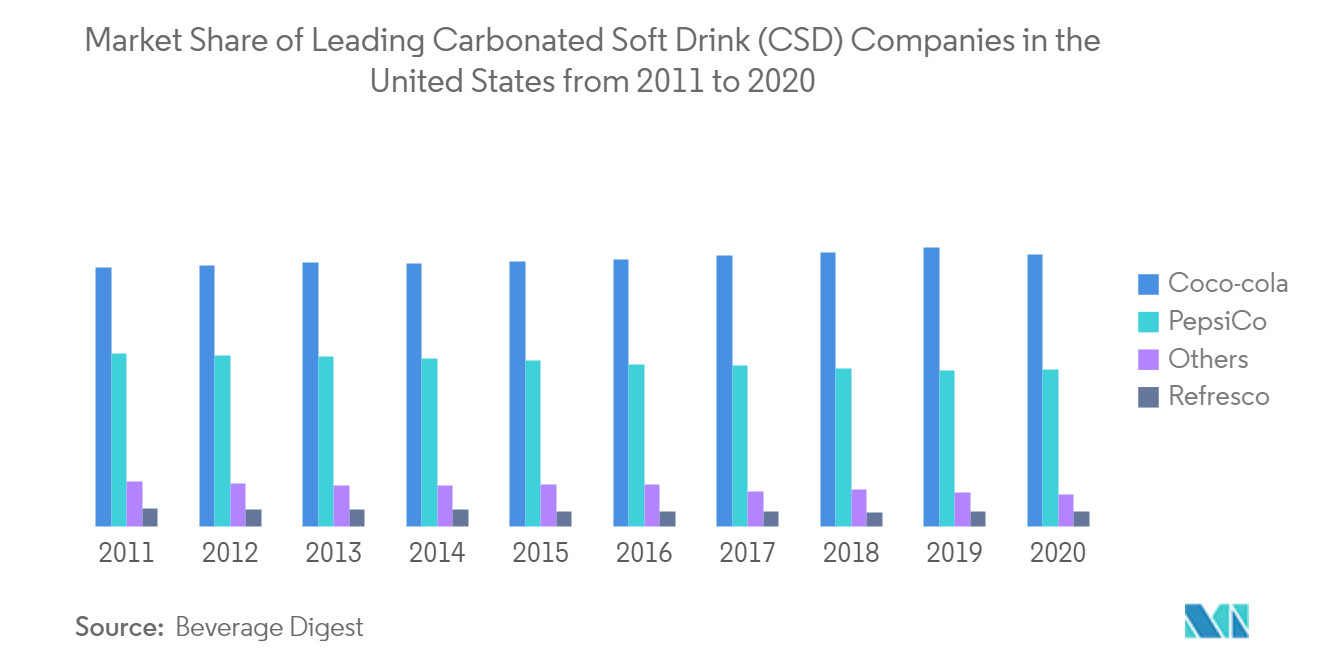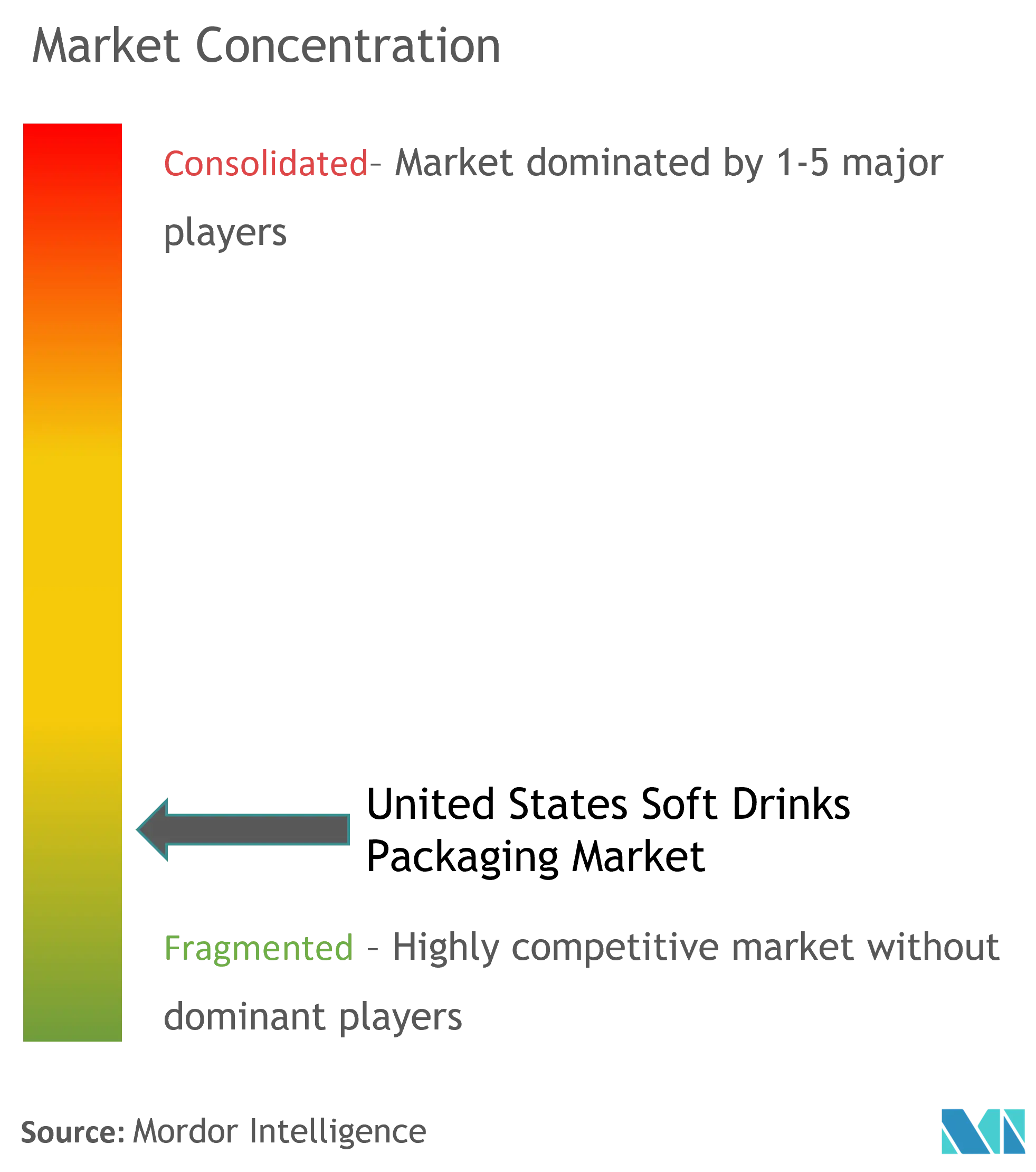US Soft Drinks Packaging Market Size

| Study Period | 2019 - 2029 |
| Base Year For Estimation | 2023 |
| Forecast Data Period | 2024 - 2029 |
| Historical Data Period | 2019 - 2022 |
| CAGR | 8.20 % |
| Market Concentration | Low |
Major Players
*Disclaimer: Major Players sorted in no particular order |
US Soft Drinks Packaging Market Analysis
The United States Soft Drinks Packaging Market is expected to grow at a CAGR of 8.2% over the forecast period (2022 - 2027). The COVID-19 pandemic harmed the soft drinks packaging market. The pandemic leads to disruptions in the supply chain in the country. Further, the solid recessionary effect and wellness and health priorities in the post-pandemic era will negatively affect the industry.
- Driven by consumer desire for a healthier lifestyle, bottled water will overtake carbonated soft drinks as the leading packaged beverage of choice among U.S. consumers. With trends toward healthier beverages threatening the growth of carbonated soft drinks, finding new and innovative ways to get consumers to buy through packaging stimuli will be crucial for packaging manufacturers and brand owners. However, the cost will still be the key ingredient to any new packaging feasibility.
- Every segment of the bottled water industry is growing, and bottled water is considered the most successful mass-market beverage category in the U.S. Single-serve PET plastic bottled water outperformed all other beverage categories, posting another significant rise.
- Further, bottled water outsells retail soft drinks in 17 major cities, including New York, Boston, Los Angeles, San Francisco, Las Vegas, Houston, Miami, and Washington D.C. Overall, soft drink consumption declines. More cities are projected will join the list.
- The majority of carbonated soft drinks are sold in aluminum cans and PET bottles. They are also sold in bulk in the foodservice industry through soda fountains. Only a tiny portion of CSDs are still packaged in glass bottles. These are usually packaged in smaller sizes due to changing consumer preferences and lifestyles and increased costs associated with transporting heavy, low-volume glass containers versus high volume-to-packaging ratio PET bottles and aluminum cans.
- Moreover, soft drinks are the second most-consumed drink after water, with plastic being the most used material for soft drinks packaging. Many beverage companies favor plastic packaging material for bottled beverages due to its lightweight, durability, and cost-efficiency.
- Further, carbonated soft drinks are usually packaged in aluminum cans. The COVID-19 pandemic impacted the supply of these cans in the early months of the pandemic, which highlighted the limitations of these cans. The can shortage made carbonated beverage producers look for new packages, specifically all forms of aseptic, enabling a long ambient shelf life.
US Soft Drinks Packaging Market Trends
This section covers the major market trends shaping the US Soft Drinks Packaging Market according to our research experts:
Plastic is Expected to Hold Significant Market Share
- Plastics are a more efficient material for soft drinks packaging than other alternatives because plastics are energy efficient to manufacture and lighter than alternative materials. For instance, just two pounds of plastic can deliver 10 gallons of Liquid, i.e., milk, whereas three pounds of aluminum, eight pounds of steel, or over 40 pounds of glass are needed to deliver the same amount of Liquid.
- Ready-to-drink iced tea has grown considerably due to the increasing demand. Market vendors are offering specialized recycle packaging for ready-to-drink tea. For instance, Graham Packaging offers recyclable plastic packaging to provide longer shelf life for single-serve packaging.
- Also, the busy life of working people has led to the launch of single-serve plastic sachets by various brands. Thus, this increases the importance of ready-to-consume drinks and further boosts market growth.
- HDPE is the most widely used type of plastic packaging material. It is used to make many types of bottles and containers. Unpigmented bottles are translucent and sturdy, have good barrier properties, and are well suited for packaging products with a shorter shelf life, such as Juices and Energy Drinks.
- With the expanding soft drinks market, it is evident that nutritional product demand, such as Juices, Energy drinks, sports drinks, is increasing, directly driving the soft drinks packaging market. It is also durable, and people can carry them without hassle. Moreover, plastics are airtight, so leakage and getting stale is unlikely.

Carbonated Beverages to hold the Largest Market Share
- The carbonated beverages market is one of the matured industries across the globe. The segment has undergone significant changes in product innovations and offerings in the last few years. To face the growing market challenges, companies are bringing new flavors keeping in mind consumers' health and wellness concerns.
- In the United States, carbonated drinks are the second most-consumed drink after water, with plastic being the most used material for soft drinks packaging. The increasing population and rising disposable income have led to the increasing demand for carbonated soft drinks products.
- The majority of carbonated soft drinks are sold in aluminum cans and PET bottles. They are also sold in bulk in the foodservice industry through soda fountains. Only a tiny portion of CSDs are still packaged in glass bottles. These are usually packaged in smaller sizes due to changing consumer preferences and lifestyles and increased costs associated with transporting heavy, low-volume glass containers versus high volume-to-packaging ratio PET bottles and aluminum cans.
- Moreover, Cola style soft drinks were the most popular carbonated beverage in the United States in 2020. The sales reached over 13 billion U.S. dollars. Citrus carbonated soft drink varieties ranked second, with sales amounting to around 4.6 billion U.S. dollars.
- Further, efficient packaging solutions offer ease of use, disposability, and enhanced user experience. These benefits have led to the demand for packaging solutions for the soft drinks segment. The other trend augmenting the demand is the new and innovative products, which helps manufacturers enhance their brand visibility while offering product differentiation.

US Soft Drinks Packaging Industry Overview
The US Soft Drinks Packaging market is highly fragmented, owing to many domestic and international players. The market is fragmented, with the players competing in terms of price, product design, product innovation, etc. Some of the major players in the market are Amcor Ltd, Sealed Air Corporation, Tetra Pak International, Graham Packaging Company, Crown Holdings Incorporated, among others.
- July 2021 - Sealed Air Corporation has dedicated more than USD b30 million in capital to expand global production capacity and invest in new equipment systems to meet the accelerating demand for Automated Packaging Systems brand solutions. The investment is for capacity expansion, 'touchless' automation, and proprietary digital printing technologies, primarily in Streetsboro and Bedford Heights, Ohio, and Keyser, West Virginia, and will be completed in 2021.
- February 2021 - Tetra Pak introduced certified recycled polymers and became the first company in the food and beverage packaging industry to be awarded the Roundtable on Sustainable Biomaterials (RSB) Advanced Products certification. Its carton packages integrating attributed recycled polymers are now available for food and beverage manufacturers.
US Soft Drinks Packaging Market Leaders
-
Amcor Ltd
-
Sealed Air Corporation
-
Crown Holdings Incorporated
-
Tetra Pak International
-
Graham Packaging Company
*Disclaimer: Major Players sorted in no particular order

US Soft Drinks Packaging Market News
- June 2021 - Amcor launched new machines to produce ultra-clear and heat resistance films. The AmPrima line uses machine-direction orientation technology to produce films that can run at speeds that competitors cannot match in a recycle-ready solution for packaging purposes.
US Soft Drinks Packaging Market Report - Table of Contents
1. INTRODUCTION
- 1.1 Study Assumptions and Market Definition
- 1.2 Scope of the Study
2. RESEARCH METHODOLOGY
3. EXECUTIVE SUMMARY
4. MARKET INSIGHTS
- 4.1 Market Overview
- 4.2 Industry Value Chain Analysis
-
4.3 Industry Attractiveness - Porter's Five Forces Analysis
- 4.3.1 Bargaining Power of Suppliers
- 4.3.2 Bargaining Power of Buyers
- 4.3.3 Threat of New Entrants
- 4.3.4 Threat of Substitute Products
- 4.3.5 Intensity of Competitive Rivalry
- 4.4 Assessment of the Impact of COVID-19 on the market
5. MARKET DYNAMICS
-
5.1 Market Drivers
- 5.1.1 Growing Demand for Ready-to-use Drinks
- 5.1.2 Increased demand for convenience packaging from consumers
-
5.2 Market Restraints
- 5.2.1 Environmental concerns regarding usage of plastic
- 5.2.2 Stringent Government Regulations
6. MARKET SEGMENTATION
-
6.1 By Packaging Material Type
- 6.1.1 Plastic
- 6.1.2 Paper & Paperboard
- 6.1.3 Glass
- 6.1.4 Metal
- 6.1.5 Other Materials
-
6.2 By Product Type
- 6.2.1 Bottled Water
- 6.2.2 Carbonated Drinks
- 6.2.3 Juices
- 6.2.4 RTD Beverages
- 6.2.5 Sports Drink
- 6.2.6 Other Products
7. COMPETITIVE LANDSCAPE
-
7.1 Company Profile
- 7.1.1 Crown Holdings Inc.
- 7.1.2 Amcor Ltd.
- 7.1.3 Tetra Pak International
- 7.1.4 Sealed Air Corporation
- 7.1.5 Graham Packaging Company
- 7.1.6 Ball Corporation
- 7.1.7 Placon Corporation
- 7.1.8 Toyo Seikan Group Holdings Ltd
- 7.1.9 WestRock Company
- 7.1.10 Owens-Illinois Inc.
- 7.1.11 Refresco Group NV
- 7.1.12 Ardagh Group SA
- 7.1.13 CAN-PACK S.A.
8. INVESTMENT ANALYSIS
9. FUTURE OUTLOOK OF THE MARKET
** Subject To AvailablityUS Soft Drinks Packaging Industry Segmentation
The primary function of packaging is to protect the product, maintain its safety and quality, and reduce transportation risk. The United States soft drink packaging market is segmented on plastic, paper, metal, and glass materials. It includes Soft drink products like juices, bottled water, sports drinks, ready-to-drink (RTD), carbonated drinks. However, the transition toward sustainable packaging lately is driving the soft drinks packaging industry to bring innovative and eco-friendly packaging solutions. This report gives a detailed study of the market landscape, including the key growth strategies, competition analysis, and key trends that will impact the industry. Further, the report provides the impact of COVID-19 on the market.
| By Packaging Material Type | Plastic |
| Paper & Paperboard | |
| Glass | |
| Metal | |
| Other Materials | |
| By Product Type | Bottled Water |
| Carbonated Drinks | |
| Juices | |
| RTD Beverages | |
| Sports Drink | |
| Other Products |
US Soft Drinks Packaging Market Research FAQs
What is the current US Soft Drinks Packaging Market size?
The US Soft Drinks Packaging Market is projected to register a CAGR of 8.20% during the forecast period (2024-2029)
Who are the key players in US Soft Drinks Packaging Market?
Amcor Ltd, Sealed Air Corporation, Crown Holdings Incorporated, Tetra Pak International and Graham Packaging Company are the major companies operating in the US Soft Drinks Packaging Market.
What years does this US Soft Drinks Packaging Market cover?
The report covers the US Soft Drinks Packaging Market historical market size for years: 2019, 2020, 2021, 2022 and 2023. The report also forecasts the US Soft Drinks Packaging Market size for years: 2024, 2025, 2026, 2027, 2028 and 2029.
US Soft Drinks Packaging Industry Report
Statistics for the 2024 US Soft Drinks Packaging market share, size and revenue growth rate, created by Mordor Intelligence™ Industry Reports. US Soft Drinks Packaging analysis includes a market forecast outlook 2029 and historical overview. Get a sample of this industry analysis as a free report PDF download.



